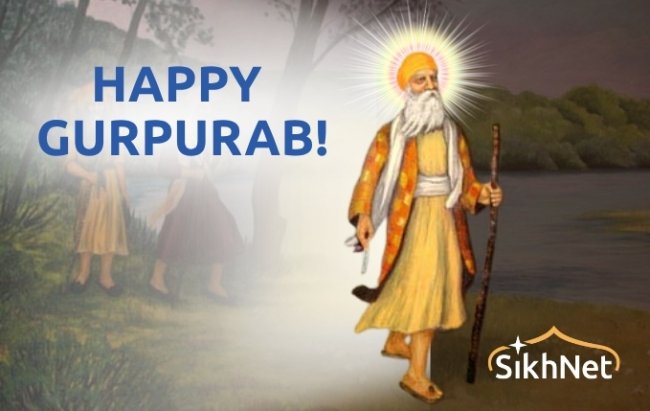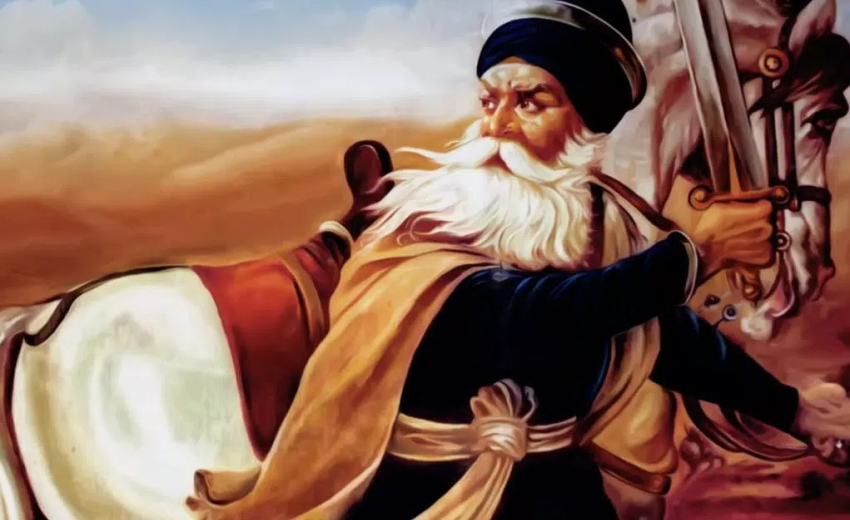Baba Deep Singh holds a special place in Sikh hearts as a cherished martyr. He is celebrated for his unwavering dedication to the teachings of Sikh Gurus and his ultimate sacrifice.
Early Life
Shaheed Baba Deep Singh Ji was born on January 20, 1682, in Pahuwind village, Amritsar district.At the tender age of 12, he accompanied his parents to Anandpur Sahib to meet the tenth Sikh guru, Guru Gobind Singh Ji. During their visit, they engaged in selfless service to the Sangat (community). When it was time for his parents to depart for their village, Guru Gobind Singh Ji asked Baba Deep Singh Ji to stay and serve him. With humility, Baba Deep Singh Ji accepted the Guru's command, embarking on a dedicated journey of service.
Gaining knowledge
Baba Deep Singh Ji, a devoted Sikh, embarked on a journey of learning at a young age. He began by acquiring the knowledge of reading and writing Gurmukhi, the sacred script of Gurbaani, and delving into its exegesis. In addition to Gurmukhi, he mastered various other languages. Guru Gobind Singh Ji, the spiritual leader, also imparted skills such as horseback riding, hunting, and weaponry to him. At the age of 18, on the auspicious Vaisakhi day in 1700, Baba Deep Singh Ji received the blessed Khande-di-paul (Amrit) from the revered Guru-roop Panj Piyaare. Being an Amritdhari Sikh, he pledged to serve in Akaal Purakh's Fauj (the Almighty's army) and uphold the Khalsa way by aiding the vulnerable, championing truth, and seeking justice. Baba Deep Singh Ji quickly earned a special place as one of Guru Gobind Singh Ji's cherished disciples.
Returning back home
Baba Deep Singh Ji served Guru Gobind Singh Ji for 8 years. At Guru Ji's request, he returned home, got married, and later met Guru Ji at Takht Sri Damdama Sahib in 1705. There, he learned that Guru's two sons, Baba Ajit Singh Ji and Baba Jujhar Singh Ji, had become martyrs in the battle of Chamkaur Sahib. Guru Ji also told him that his younger sons, Baba Zorawar Singh Ji and Baba Fateh Singh Ji, were cruelly bricked alive and became martyrs in Sirhind under Governor Wazir Khan's orders.
In 1706, Guru Gobind Singh Ji appointed Baba Deep Singh Ji to lead Sri Damdama Sahib, while Bhai Mani Singh Ji became Head Granthi at Sri Harmander Sahib in Amritsar. After Guru Sahib went to Delhi, Baba Deep Singh Ji took on the task of making copies of Sri Guru Granth Sahib Ji and continued the service bestowed by Guru Gobind Singh Ji in running this Sikh Center. 'Taksaal' means a place where things are made. Sri Damdama Sahib had turned into a place where Sikhs came to craft their weapons and enrich their minds with Gurbaani by learning the right way to read Sri Guru Granth Sahib Ji. As a result, this hub of learning and weaponry became known as 'Damdami Taksaal'. Baba Deep Singh Ji dedicated many years to preaching Sikh principles and serving the Sangat. He was always ready to assist those in need and stand up for justice.
Standing up against tyrants
In 1709, Baba Ji teamed up with Baba Banda Singh Ji Bahadar to punish the oppressors in Sadhaura and Sirhind. Later, in 1733, Nawab Kapoor Singh Ji, the Khalsa forces' commander, appointed Baba Ji as the leader of one of the groups within Dal Khalsa, a united body of Khalsa groups across Panjab. Then, on Vaisakhi day in 1748, as Dal Khalsa restructured into twelve misls, he was chosen to lead Shaheedaa(n) di Misl.
In April 1757, Ahmed Shah Abdali was heading back to Kabul from Delhi with lots of valuable things and people he had taken captive during his fourth invasion. The Singhs came up with a plan to get back the treasures and free the prisoners. Baba Deep Singh Ji's group was stationed near Kurkhetar (also known as Kurukshetra). They managed to rescue many prisoners.
While leaving Lahore, Abdali appointed his son Taimur Shah as the Governor of Lahore and instructed him to take action against the Sikhs. Following these orders, Taimur Shah began destroying Gurdwaré and contaminating the sarovars (pool tanks) with debris and alcohol. When Baba Deep Singh Ji learned about this sacrilege and the demolition of Sri Harmandar Sahib, he shared the news with the congregation at Takht Sri Damdama Sahib, declaring that Diwali would be celebrated at Amritsar that year. Five hundred Singhs volunteered to accompany him, and before setting out for Amritsar, Baba Deep Singh Ji prayed, "May my head fall at Sri Harmandar Sahib."
Baba Ji in Amritsar
At the age of 75, Baba Deep Singh Ji displayed the vigour of a young warrior. Leading a sizable group of Sikhs, he embarked on a determined journey towards Sri Harmandar Sahib. As they approached Taran Taaran, located ten miles from Amritsar, the Singh's ranks swelled to approximately 5,000. There, Baba Ji marked a line on the ground using his Khanda (double-edged sword) and called upon only those ready to fight and make the ultimate sacrifice for their Guru, leaving behind their worldly ties, to step across. With unwavering resolve, those willing to lay down their lives for the Guru and forsake their homes and families courageously crossed the line as Baba Deep Singh Ji recited the sacred shabad.
ਜਉ ਤਉ ਪ੍ਰੇਮ ਖੇਲਣ ਕਾ ਚਾਉ ॥ ਸਿਰੁ ਧਰਿ ਤਲੀ ਗਲੀ ਮੇਰੀ ਆਉ ॥
ਇਤੁ ਮਾਰਗਿ ਪੈਰੁ ਧਰੀਜੈ ॥ ਸਿਰੁ ਦੀਜੈ ਕਾਣਿ ਨ ਕੀਜੈ ॥20॥
"Those who wish to play the game of love (follow the Guru's path), come to me with your head in your palm. If you wish your feet to travel this path, don't delay in accepting to give your head." (Ang 1412, SGGS)
Fight against Mughals
When the Singhs were coming, the Governor of Lahore sent an army of twenty-thousand soldiers to meet them. This army set up camp six miles north of Amritsar and waited for the Singhs. On November 11, 1757, both armies met near Gohalwarh. The Singhs fought bravely and pushed the enemy army back. They reached Chabba village where a a fierce battle took place. During the fight, Attal Khan struck a fatal blow, severing the head of Baba Deep Singh Ji from his body.
Baba Deep Singh was losing his balance under the impact of the strong blow when a fellow Sikh reminded him of his vow to reach the Parkarma of Sri Darbar Sahib. Upon hearing this, he was filled with divine strength. He placed his head on one hand and fiercely swung his 14kg Khanda sword with the other hand, causing enemy soldiers to flee in fear. With great determination, Baba Deep Singh reached the Parkarma of Sri Harmandar Sahib, but sadly, due to his severe injury, attained martyrdom.
Peacefully rests at Harmandir Sahib
In 1757, the Singhs joyfully celebrated Diwali at Sri Harmandar Sahib. A stone now marks the spot where his head had fallen. Sikh devotees pass by this place as they pay their respects at Sri Darbar Sahib. It serves as a poignant reminder that the path to Sri Darbar Sahib is paved with the sacrifices of heroes like Shaheed Baba Deep Singh Ji.
Inspiration for Sikhs
Baba Deep Singh Ji's martyrdom inspired Sikhs to fight against oppression for many years. Today, his life sets an example for all Sikhs on how to live and die with dignity and never tolerate disrespect to Sri Guru Granth Sahib Ji or the Guru Ghar (Gurdwara). This message is something we can all learn from and strive to follow. It reminds us to uphold the respect and dignity of Gurmat and Sri Guru Granth Sahib Ji. In recent years, there has been a growing concern about some Gurdwaras allowing events with alcohol and Granthi Singhs taking Guru Ji's Saroops to inappropriate places, emphasizing the importance of preserving our sacred values.
Dhan Guru, Dhan Guru Ke Piaare.
Dhan Shaheed Baba Deep Singh Ji.
ਧੰਨ ਉਹ ਧਰਤੀ ਧੰਨ ਉਹ ਬਾਪੂ, ਧੰਨ ਵਡਭਾਗੀ ਮਾਈ ।
ਢੰਗ ਜਿਉਣ ਦਾ ਜਿਸਦਾ ਪੁੱਤਰ, ਦੱਸ ਗਿਆ ਸਦੀਆ ਸਾਈਂ ।
"Blessed is that land, blessed is that father, blessed is the great mother, Whose son has shown the way to live, for centuries to come."
*Based on an article by Manvir Singh, published in his blog post on 25th January 2021

